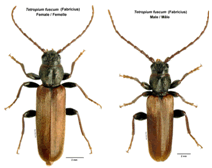
An infestation of the brown spruce longhorned beetle (BSLB) was discovered in a park in Halifax, Nova Scotia in 1999 (Anderson, 2022), where it was killing red (Picea rubens) and white spruce (P. glauca) (Smith and Hurley, 2000). The beetle is thought to have been introduced on solid wood packaging material through the port of Halifax (Ontario’s Forests, 2000). Museum collections indicated that it had been present since at least 1990, but was misidentified as the North American native congener Tetropium cinnamopterum (Anderson, 2022).
BSLB is native to Eurasia, ranging from Lapland to Japan. In its native habitat, it feeds primarily on dead, felled, or stressed spruce, but it will also attack pines (Pinus spp.), fir (Abies spp.), larch (Larix spp.), and some hardwood species (Ontario’s Forests, 2000). Trees are girdled when larvae tunnel under the bark in the cambial layer. Healthy, non-stressed spruce trees – now including black spruce (P. mariana) and the European host Norway spruce (P. abies) — have been successfully attacked in Nova Scotia, suggesting that there may be less resistance in North American spruce than European species (Ontario’s Forests, 2000).
Canadian authorities initially undertook an eradication campaign in which they cut and chipped infested and nearby vulnerable trees (Cox 2000; Canadian Forestry Service, 2001). While eradication efforts have ceased, the Canadian Food Inspection Service continue with annual surveys (J. Sweeney, CFS, pers. comm.). These surveys show that in 30 years, BSLB has spread only 150 km from its initial point of introduction. While Nova Scotia is considered infested, BSLB detections have occurred in only a small area of neighboring eastern New Brunswick (Anderson, 2022); spruce mortality is low in the region (J. Sweeney pers. comm.).
In Nova Scotia, BLSB coexists with a native congener, Tetropium cinnamopterum. The two beetles are ecologically similar; the introduced BLSB tends to infest healthier trees and has a narrower host range than its North American counterpart (Anderson, 2022).
One hypothesis offered to explain why BLSB has not spread is that it mates with the native beetle, T. cinnamopterum, resulting in nonviable offspring. Such interspecific mating would likely occur most often at the edge of the infestation where the native beetle is more abundant than the introduced BLSB. If, however, the hybrid offspring are viable and fertile, the prodigy might have both a propensity to attack healthy tress (from the BSLB parent) and a wider host range (from the native T. cinnamopterum); such a scenario would present an inherently greater threat to North American conifers. These questions are presently being explored (Anderson, 2022).
United States Forest Service (USFS) scientists and managers developed a conservation priority-setting framework for forest tree species at risk from pests, pathogens, and other threats. The Project CAPTURE (Conservation Assessment and Prioritization of Forest Trees Under Risk of Extirpation) uses FIA data and expert opinion to group tree species under threat by non-native pests into vulnerability classes and specify appropriate management and conservation strategies. The scientists prioritized 419 tree species native to the North American continent. The analysis identified 15 taxonomic groups requiring the most immediate conservation intervention because of the tree species’ exposure to an extrinsic threat, their sensitivity to the threat, and their ability to adapt to it. Each of these 15 most vulnerable species, and several additional species, should be the focus of both a comprehensive gene conservation program and a genetic resistance screening and development effort. Brown spruce longhorned beetle is not known to be a threat to any of these 15 most vulnerable species.
Sources
Anderson, J.L., S.B. Heard, J. Sweeney, D.S. Pureswaran. 2022. Mate choice errors may contribute to slow spread of an invasive Eurasian longhorn beetle in North America. NeoBiota 71: 71–89. https://doi.org/10.3897/ neobiota.71.72843
Canadian Forest Service, Atlantic Forestry Centre. https://cfs.nrcan.gc.ca/index/brownsprucelonghornbeetle, accessed July 2004.
Cox, Kevin. June 24, 2000. Does this bug deserve to die? Globe and Mail.
Ontario’s Forests, Forest Health. 2000. Questions and answers about the brown spruce longhorned beetle – Tetropium fuscum (Fabr.). July 6, 2000. https://www.mnr.gov.on.ca/mrn/forests/foresthealth/brown%20spruce/longhorn%5Fbeetle.htm.
Potter, K.M., Escanferla, M.E., Jetton, R.M., Man, G., Crane, B.S., Prioritizing the conservation needs of US tree spp: Evaluating vulnerability to forest insect and disease threats, Global Ecology and Conservation (2019), doi: https://doi.org/10.1016/
Smith, G., and J. E. Hurley. 2000. First North American record of the Palearctic species Tetropium fuscum (Fabricius) (Coleoptera: Cerambycidae). Coleopterists Bull. 54: 540.



